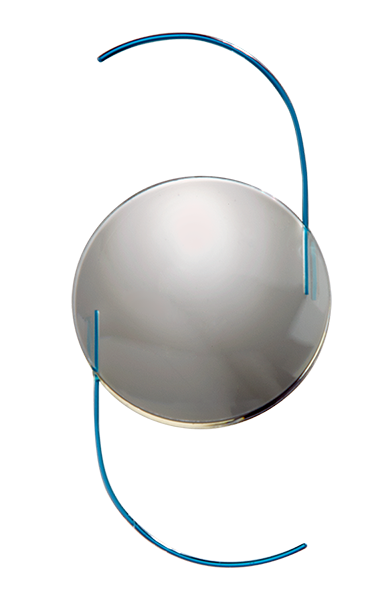Cataracts are a clouding of your eye’s natural lens. They slowly develop over time, when proteins in the lens start to clump together, blocking light and causing blurry, dull vision. About 24 million Americans have cataracts. They typically start to develop by age 55, but they can start earlier, as one in six people over age 40 has a cataract. However, it isn't unusual for patients under 50 to develop cataracts associated with diabetes, certain medical conditions, family history, or sometimes, just sporadically.


If you’re having difficulty going about daily activities, such as reading or driving, because of blurred vision then you may have a cataract. This is the time to call Clemson Eye to book an eye exam to avoid the risk of compromised vision. We recommend annual eye exams for everyone to ensure ongoing visual health. If you are experiencing any of these signs of a cataract or notice any changes in your vision, book an eye exam immediately.
Cataracts can create symptoms including:
Click on the symptoms below to see a visualization.






The eye surgeons at Clemson Eye were among the first in the country to perform laser-assisted cataract surgery with premium lens implants. To do this, they use the most advanced laser-guided surgery systems available today.
Laser cataract surgery results in much more precise incisions, less stress on the eye and less damage to the eye’s delicate tissues. The highly customized procedure involves a tiny 2.2 mm stitch‑less laser incision and the replacement of the diseased, cloudy lens with a clear lens implant.
Using the FDA-approved LenSx® laser, Clemson Eye surgeons create incisions that are up to 10 times more precise than manual incisions. During the 15-minute surgery, patients are comfortably awake and experience clear vision during a quick recovery. The precision and customization of laser cataract surgery is perfectly suited to patients seeking an improved visual outcome through an advanced lens implant. There are different types of advanced intraocular lens implants that can correct nearsightedness, farsightedness and/or astigmatism during the same cataract removal procedure.
Through laser cataract surgery with premium lenses, we can deliver the best possible visual outcomes for our cataract patients. Regardless of their age, Clemson Eye patients enjoy excellent restored vision, whereby they are entirely free of or much less dependent on eyeglasses.

Clemson Eye is delighted to provide laser-guided cataract surgery using Alcon’s LenSx® laser. This revolutionary laser takes cataract surgery to new levels with its unparalleled precision and customization. The innovative technology integrates computer control into crucial steps of the procedure, offering cataract patients the most cutting-edge surgical option available.

No-stitch cataract surgery allows for quick recovery with minimal discomfort and enhanced vision without the need for stitches. By creating a small incision at the edge of the cornea, our cataract surgeons can remove the cataract and insert the IOL without the use of sutures. The area will naturally heal and seal, reducing discomfort and irritation that can sometimes be caused by stitches.


If you think you might need cataract surgery, the first step is to have a comprehensive eye examination. Your doctor will be able to determine if a cataract is the cause of your decreased vision. If it is, and if it is inhibiting your quality of life and the activities that bring you joy, then our surgeons can help you determine which cataract surgery option is best for your eyes and lifestyle.
Most patients have two choices when it comes to lens implants: standard lens implants or high-tech lens implants. Your cataract surgeon will make a recommendation based on your vision goals and the current anatomy and health of your eyes. However, ultimately, the decision will be up to you. Some of the advanced IOL options we offer include:
Medicare and most health insurance plans cover the cost of basic cataract surgery, excluding deductibles, coinsurance and copays. If you are interested in an advanced lens implant or laser cataract procedure than an additional payment is required. If you’re a Clemson Eye patient, you have the option of 24‑month, 0% payment plans for any out of pocket expenses.
Our highly experienced cataract surgeons always take the time to discuss the best possible surgical solutions for your visual health and individual situation. They’ve performed over 100,000 cataract operations, and all offer basic and advanced laser cataract surgery to restore your best vision. After your consultation, our surgical team will provide you details of your visual and financial options. Supporting a cataract procedure that is customized to meet your lifestyle visual needs is our goal.
In most cases, we schedule cataract surgery for each eye 1-2 weeks apart, assuming both eyes need surgery. However, in some situations, bilateral cataract surgery is necessary and scheduled.
You will usually be at the surgery center for about 2 hours, but on average the surgery only takes about 15 minutes.
In most cases, general anesthesia (put to sleep) is not necessary to perform cataract surgery. Our anesthesia team will provide some light sedation to help you relax. Numbing drops ensure you will not have any pain. For the short procedure, you will be awake and likely will not remember the surgery.
No. Eye drops are used to numb the eye and patients often see a spectrum of colored lights.
Many will feel comfortable driving, but there are also many who may have an imbalance between their eyes after their first surgery. Those who have an imbalance and reduced depth perception are encouraged to limit driving during the week between surgeries. In addition, caution should be taken while walking up and down stairs and curbs after the first eye if the depth perception is initially reduced.
The most important thing is not to rub your eye. You will need to wear a clear, plastic shield at night for the first week to help protect the eye. Although the risk of infection is rare, we also ask you to avoid swimming in pools and hot tubs for the first two weeks.